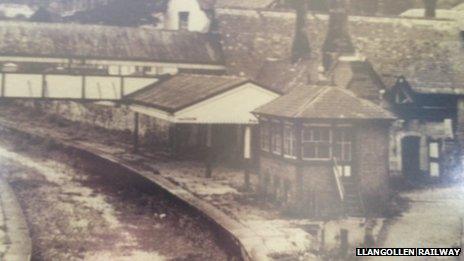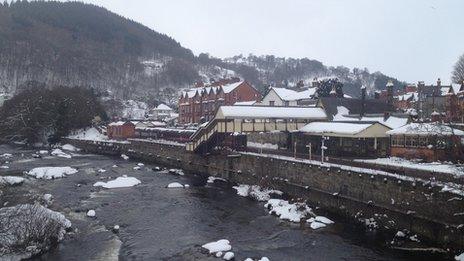Fifty years since Beeching's rail cuts in Wales
- Published

Dr Richard Beeching presented his report on the railways on 27 March, 1963
It is 50 years since the biggest shake-up of the rail network ever announced in Britain was published.
The Beeching report of 1963 led to 189 stations in Wales being earmarked for closure, with lines and tracks ripped-up the length and breadth of the country in the decade to follow.
But despite the report some Welsh lines have stubbornly refused to fade away.
In fact, 32 stations have re-opened, and on Tuesday it was announced Newport could be in line for a new station.
The Beeching report, officially titled The Reshaping of British Railways, set out with one aim - to cut the mounting debts of the nationalised British Rail.
Chemical company boss Dr Richard Beeching was given the job, despite famously telling the Daily Mirror newspaper: "I have no experience of railways, except as a passenger. So I am not a practical railwayman. But I am a very practical man."

In 1963, Beeching wanted to close 189 stations across Wales - cutting most of the branch lines
He took what many saw as a simple accounting view of the branch lines that criss-crossed the country. If they could not turn a profit, and were not carrying sufficient passengers, then the axe should fall.
To go in Wales, the Carmarthen-Aberystwyth line, the Bangor-Amlwch service, branch service to Caernarfon, the end of the Ruabon to Barmouth line, Abercynon to Aberdare, Porth to Maerdy, Barry to Bridgend - the list went on, and on.
The closure list was already on top of another 166 Welsh stations and halt-stops put forward prior to the Beeching cuts.
In the words of one BBC news broadcaster of the day: "There's never been a Doomsday book of British railways like this.
"More than 2,000 stations will be closed. Wholesale shut down of passenger services will leave huge areas of the country to the buses. Every part of the country is affected.
"In Wales too, they are drastically reduced. Many of the country services are doomed, leaving only three main links east and west."
But while the axe did begin to fall - and fall swiftly in Wales, some stations and lines found themselves saved from the chop.
Lines like the Conwy Valley found themselves in favour of then Prime Minister Harold Wilson, who had enthused about the "white heat of technology" rebuilding Britain.
"The situation at the time was that they were building a new power station at Trawsfynydd," explained Larry Davies, Arriva Trains Wales' community manager on the line today.
"Although there were a lot of local protest from people as one would expect, I think the traffic that came from the power station saved the Conwy Valley line."
The nuclear power station is now decommissioned, and the last flask of empty nuclear fuel rods travelled on the lines in 1995.
But because of the investment on the line in the 60s, it remains thriving.

Abandoned and falling down - the initial fate of Llangollen railway station in the late 1960s
"It's a lifeline for this community, and a good connection and amazing benefit to the tourism and economy of the area, with our links with the Ffestiniog Railway and a lot of people doing the round-trip of Snowdonia," added Mr Davies.
Steam rising
But it was a different story in north-east Wales - where the service on the Ruabon to Barmouth line came to a halt in January 1965 - leaving the flagship Llangollen station to rot away over the next decade.
Then, a group of rail enthusiasts from Denbighshire and Flintshire stepped in, determined to make a difference.
"The big question was 'what do we do with this station, which is in a prime location?'" said George Jones, from Llangollen Railway Trust.
"Interestingly, it was the council officer who said maybe it could become one of the these increasingly popular steam heritage centres."
That was at the turn of the 1970s. Today, the Llangollen Railway runs for more eight miles between the town and the former Bonwm Halt.
It is the longest stretch of preserved standard gauge line in Wales, running steam locomotives with enticing names such as the "GWR Foxcote Manor" and the "LMS Stanier Black 5 44806".
"Well, it has certainly been a challenge. The amount of dedication that has been put into recreating this railway as a heritage line," said Mr Jones.
"Of course, the challenge is ongoing. We are still attempting to get through to Corwen and have a 10 mile town-to-town railway through what is really the most scenic part of the Dee Valley."
Other stations across Wales have also risen from the Beeching ashes, but the drivers here have been economic.

Llangollen station has been completely rebuilt and is now an important visitor attraction for north Wales
The Bridgend line now connects south Wales with a direct route to Cardiff Airport, following a £17m investment in 2005.
Stations such as Goodwick in Pembrokeshire are once again hosting passengers, while the valleys have witnessed the rebirth of Llanharan, and the once shut Abercynon-Aberdare line is now bustling.
The Ebbw Vale line, though not officially a Beeching cut, has been re-opened since 2008 - a vital boost to the local economy after the closure of the town's massive steelworks.
And more stations could be opening in the future.
On Tuesday, the UK transport secretary said that Pye Corner in Newport was a "front-runner" in a bid to win new funds for new stations.
The service would be on the line between Cardiff and Ebbw Vale, will serving the area of Bassaleg.
There are also feasibility studies underway involving Bow Street and Carno in Ceredigion, while a long-running campaign has been mounted to see services expand on the old Amlwch line on Anglesey.
Earlier this week also saw the publication of the Metro Consortium report on the future of rail transport in south-east Wales. It is seeking backing for a whole raft of new measures to bring new train services to Cardiff, Newport and the Valleys.
So despite the Beeching report of 1963 - it seems in 2013, there remains an appetite for rail in Wales.
- Published22 March 2013
- Published8 January 2013
- Published2 January 2013